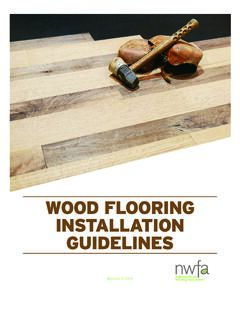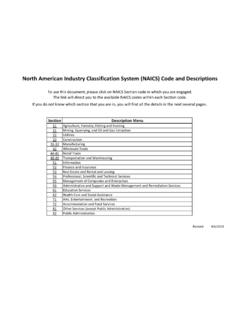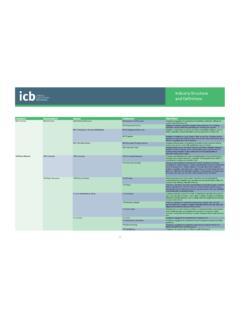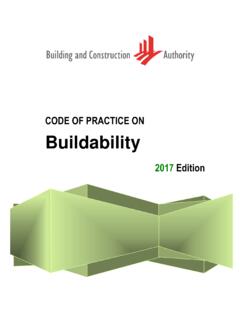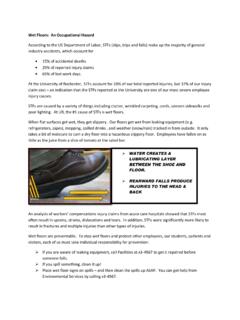Transcription of Asbestos Standard for the Construction Industry
1 Asbestos Standard forthe Construction IndustryOSHA 30962002 (Revised)This informational booklet providesa generic, non-exhaustive overview of aparticular topic related to OSHA does not alter or determine complianceresponsibilities in OSHA standards or theOccupational Safety and Health Act of interpretations and enforcementpolicy may change over time, you shouldconsult current administrative interpretationsand decisions by the Occupational Safety andHealth Review Commission and the Courtsfor additional guidance on OSHA publication is in the public domain andmay be reproduced, fully or partially, withoutpermission.
2 Source credit is requested butnot information is available to sensoryimpaired individuals upon phone: (202) 693 1999;Teletypewriter (TTY) number: (877) 889 Standardfor the Department of LaborElaine L. Chao, SecretaryOccupational Safety and Health AdministrationJohn L. Henshaw, Assistant SecretaryOSHA 30962002 (Revised)ivvContentsIntroductionWhat is Asbestos ?.. 1 What are the dangers of Asbestos exposure?.. 1 What Construction activities does this booklet cover?.. 1 Provisions of the OSHA StandardWhat is work classification?.. 3 What is the permissible exposure limit for Asbestos ?
3 4 Which Asbestos operations must employersmonitor and assess?.. 4 What is the function of a competent person? .. 4 What is an initial exposure assessment?.. 5 What is a negative exposure assessment?.. 6 Are employers required to perform exposure monitoring?.. 6 When must employers conduct periodic monitoring? .. 7Is additional monitoring ever needed?.. 8 Are employers required to establish medicalsurveillance programs for employees?.. 8Do employers have to keep any employee records?.. 10 What is a regulated area?.. 12 Who is responsible for communicatingasbestos hazards at worksites?
4 14 Does the OSHA Standard require theposting of warning signs?.. 15 Must employers provide Asbestos warning labels?.. 16Do employers have to train employeesregarding Asbestos exposure?.. 16viMethods of ComplianceWhat methods must employers use to controlasbestos exposure levels?.. 19 What are the compliance requirements for Class I work?.. 20 What are the compliance requirements for Class II work?.. 23 What are the compliance requirements for Class III work?.. 27 What are the compliance requirements for Class IV work?.. 28 Does the competent person have duties thatapply to more than one work class?
5 28 What does the OSHA Standard requireconcerning respirators?.. 29Do employers have to provide protectiveclothing for employees?.. 31 What are the hygiene-related requirements for employeesperforming Class I Asbestos work involving more than25 linear feet or 10 square feet of thermal system insulationor surfacing ACM or PACM?.. 32 What are the hygiene-related requirements for employeesperforming other Class I Asbestos work and Class II and IIIasbestos work where exposures exceed a PEL or where anegative exposure assessment has not been produced?.. 34 What are the hygiene-related requirementsfor employees performing Class IV work?
6 35 What are an employer s housekeeping responsibilities?.. 35 Quick Reference of Provisions by Work 37 OSHA AssistanceWhat are safety and health systemmanagement guidelines?.. 43 What are state programs?.. 44 How do I obtain consultation services?.. 44viiWhat are Voluntary Protection Programs (VPPs)?.. 45 What is the Strategic Partnership Program?.. 46 Does OSHA offer training and education?.. 46 Does OSHA provide any information electronically?.. 47 How do I learn more about related OSHA publications?.. 48 How do I contact OSHA about emergencies, complaints,or further assistance?
7 48 OSHA Office DirectoryOSHA Regional 49 OSHA Area 50 OSHA-Approved State 53 OSHA Consultation 56viii1 IntroductionWhat is Asbestos ? Asbestos is the generic term for a group of naturallyoccurring, fibrous minerals with high tensile strength,flexibility, and resistance to heat, chemicals, and the Construction Industry , Asbestos is found in installedproducts such as sprayed-on fireproofing, pipe insulation,floor tiles, cement pipe and sheet, roofing felts and shingles,ceiling tiles, fire-resistant drywall, drywall joint compounds,and acoustical products. Because very few Asbestos -containing products are being installed today, most workerexposures occur during the removal of Asbestos and therenovation and maintenance of buildings and structurescontaining are the dangers ofasbestos exposure?
8 Asbestos fibers enter the body when a person inhalesor ingests airborne particles that become embedded in thetissues of the respiratory or digestive systems. Exposureto Asbestos can cause disabling or fatal diseases such asasbestosis, an emphysema-like condition; lung cancer;mesothelioma, a cancerous tumor that spreads rapidly inthe cells of membranes covering the lungs and body organs;and gastrointestinal cancer. The symptoms of these diseasesgenerally do not appear for 20 or more years after Construction activitiesdoes this booklet cover?The Asbestos Standard for the Construction Industry (29 CFR Part , see ) regulatesasbestos exposure for the following activities: Demolishing or salvaging structures where Asbestos Removing or encapsulating Asbestos -containing material(ACM).
9 Constructing, altering, repairing, maintaining, orrenovating Asbestos -containing structures or substrates. Installing Asbestos -containing products. Cleaning up Asbestos spills/emergencies. Transporting, disposing, storing, containing, andhousekeeping involving Asbestos or Asbestos -containingproducts on a Construction : The Standard does not apply to Asbestos -containingasphalt roof coatings, cements, and ofthe OSHA StandardOSHA has established strict exposure limits andrequirements for exposure assessment, medical surveillance,recordkeeping, competent persons, regulated areas, andhazard is work classification?
10 The OSHA Standard establishes a classification systemfor Asbestos Construction work that spells out mandatory,simple, technological work practices that employers mustfollow to reduce worker exposures. Under this system, thefollowing four classes of Construction work are matchedwith increasingly stringent control requirements: Class I Asbestos work is the most potentially hazardousclass of Asbestos jobs. This work involves the removalof Asbestos -containing thermal system insulation andsprayed-on or troweled-on surfacing materials. Employersmust presume that thermal system insulation and surfacingmaterial found in pre-1981 Construction is ACM.










